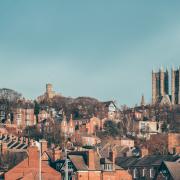Never visited Pocklington? Then put it on your to-do list now, says Richard Darn. Photographs by Joan Russell

So here’s today’s big question. Why isn’t the Yorkshire Wolds better known across this great nation of ours? It’s a conundrum that has puzzled me for years. The county has two-and-a-bit national parks (Yorkshire Dales, North York Moors and a small chunk of the Peak District) plus a brace of wonderful areas of outstanding natural beauty (Nidderdale and the Howardian Hills). But the Wolds was never granted one of these landmark designations. Yet it possesses a unique landscape and is bursting with so many exceptional historic sites that it ranks alongside Avebury and Stonehenge in importance.
Don’t believe me? Then wander through the amazing 10ft high ramparts of 3,000 year-old Huggate Dyke, marvel at any of the 1,600 Bronze Age burial mounds that dot the countryside or take a trip to the deserted medieval village of Wharram Percy. It may seem tranquil today, but this area has seen plenty of hustle and bustle in the past.
But I’m as guilty as anyone of turning a blind eye to the county’s treasures. Despite being Yorkshire born and bred I’ve hardly ever visited Pocklington, a settlement of just 8,000 souls and the gateway to the Wolds. That proved to be a big mistake on my part - this is a small town that packs a big punch!
Pocklington’s name is derived from Old English and means the settlement of Pocela’s people. But its human habitation goes back much further. It was a key location of the Iron Age Parisi people who left behind amazing chariot burials such as the one uncovered in nearby Wetwang in 2001. In a previous life I was involved in the public unveiling of this remarkable find which yielded fascinating grave goods including a horse harness and then defied every one’s expectations by proving to be a female.
By the time of the Domesday Book the town was possibly the second largest in Yorkshire with its prosperity built on the woollen trade. A further mark of importance was its inclusion on the 14th century Gough Map, the oldest of its kind in the UK. The place has continued to thrive judging by a busy town centre with plenty of independent shops and a vibrant arts scene.
Pocklington Arts Centre regularly lures top performers and ranks as a small venue with a big national reputation. Check out their website to see the impressive listings. And a short drive into the Wolds brings you to the Robert Fuller Gallery, showcasing paintings and sculptures by the celebrated wildlife artist and staging events through the year.
Dominating the town centre is the beautiful Grade I listed All Saints Church, located on slightly elevated ground and still the beating heart of the town. Begun in the 12th century, it took 200 years to complete and its location is everything. Here in 627 AD Paulinus, on a mission from the Pope, dipped the head of Anglian pagans into the beck to complete their conversion to Christianity. In the world of religion this is seriously impressive name dropping for a parish church. Since then the spot has been venerated.
Just a little way outside the town there’s a reminder that Pocklington occupied prominent roles in two world wars. The surrounding countryside was used as a training ground for men on their way to the Western Front and the town cowered under a raid by German Zeppelins in 1916. Pocklington’s one-legged town crier hopped around the neighbourhood to alert the population, but the airships erroneously dropped their bombs on nearby Barmby Moor, where fires were lit as a decoy to protect York.
In World War Two, the RAF built a major airfield on the town’s outskirts in 1940. From here Wellington and Halifax bombers took off to grope their way through the darkness to targets in occupied Europe. The bravery of these young men still makes a deep impression.
Today the aerial link has not been lost as part of the site is home to the Wolds Gliding Club. If you fancy taking to the air for a lesson you can rest assured the views are spectacular.
Another star attraction locally is Burnby Hall Gardens, home to a national collection of hardy water lilies. This haven of tranquillity was inspired by adventurer and environmentalist Major Percy Marlborough Stewart. One day he said to his wife ‘we’re terribly dull people, let’s travel around the world and then we shall have something to talk about’. He did, completing eight major tours up to 1926 and bringing back plants and artefacts to Pocklington. The gardens are a lasting tribute to a remarkable couple.
There’s is a lot to this old town. As the sun pieced the dark clouds illuminating a Wolds hilltop in the distance I vowed to return soon. w



























